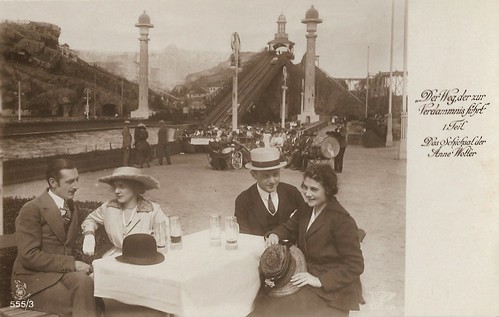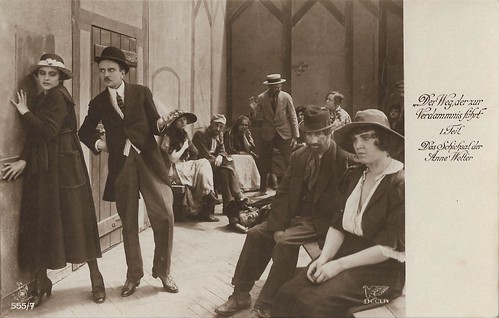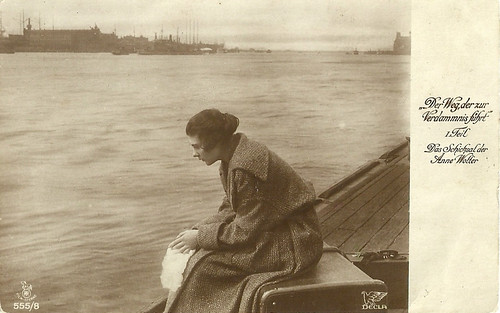Yesterday, EFSP had a post on Otto Rippert's Das Glück der Frau Beate/The happiness of Mrs. Beate (1918). Today, another film by Rippert from 1918, Der Weg, der zur Verdammnis führt, I. Das Schicksal der Änne Wolter/The Fate of Anne Wolter, starring Charlotte Bocklin. Der Weg, der zur Verdammnis führt/The Road to Damnation (1918) was a two part-'Sittenfilm', an exploitation film about white slavery. Both parts were directed by Rippert, and the second part was called Hyänen der Lust/Hyenas of Lust (1919). They were a box office hit.

German postcard by Rotophot in the Film-Sterne series, no. 555/5. Photo: Decla. Publicity still for Der Weg, der zur Verdammnis führt, I. Das Schicksal der Änne Wolter (Otto Rippert, 1918) with Charlotte Böcklin sitting far right.
In Der Weg, der zur Verdammnis führt, I. Das Schicksal der Änne Wolter/The Road to Damnation, 1. The Fate of Anne Wolter (Otto Rippert, 1918), Anne Wolter (Charlotte Böcklin) falls in the hands of scheming white slave traders.
In the second part, two other girls fall in the hands of the white slave traders, the two naive girlfriends Ilse von Giersdorf (Käthe Haack) and Lilly Gross (Grete Weixler). The two very young girls pass their first night in a disputable club and soon fall into the hands of the merciless white slave traders Madame Duval (Margarete Kupfer) and Ignatz Czyslow (Guido Herzfeld).
Änne Wolter, the protagonist of the first part, is taken to a bordello to Cairo, while Ilse ends up in the house of pleasure of Madame Forget (Rosa Murger) in Valencia and eventually ends up in Cairo as well. There, with the help of a young-girls-protection association, her father (Paul Otto) manages to free Ilse from the clutches of the ruthless gangs. Änne, though, does not survive her suffered tortures.
In name, the film was made by the Gesellschaft zur Bekämpfung des Mädchenhandels (Society for the Struggle Against White Slavery) to inform the public about the trafficking of European girls and their impressment into prostitution, often in South America.
The whole film premiered at the Berlin Marmorhaus on 1 August 1919. The cinematography was by the notable Carl Hoffmann, the script was by Julius Sternheim, and the film was produced by Erich Pommer. It was a huge success at the box office.

German postcard by Rotophot in the Film-Sterne series, no. 555/5. Photo: Decla. Publicity still for Der Weg, der zur Verdammnis führt, I. Das Schicksal der Änne Wolter (Otto Rippert, 1918) with Charlotte Böcklin. The man may be the white slave trader Ignaz Czyslow (Guido Herzfeld).
Director Otto Rippert (1869-1940), a former stage actor, had already started his film career in 1912 as actor in the Titanic disaster film In Nacht und Eis/In Night and Ice (Mime Misu, 1912), produced by Continental Kunstfilm. He then became director for Continental Kunstfilm, where he made some 10 films.
Rippert had his breakthrough in 1916 with the internationally commercially and artistically successful serial film Homunculus, starring Olaf Fönss. A group of scientists, led by a Professor Ortmann (Ernst Ludwig), produce a living human child using scientific processes - a 'homunculus'. This creature is human in every way, except that he cannot experience love. During World War I, Homunculus was the most popular and influential serial in Germany. The film was a coproduction of Deutsche Bioscop and Decla.
From then on, he worked for Erich Pommer's Decla-Film. In the later 1910s he directed various films there with Ressel Orla, e.g. Arme Lena!/Poor Lena! (1918), and Hella Moja, e.g. Die Tochter der Gräfin Stachowska/The Daughters of Countess Stachowska (1917); Das Mädel von nebenan/The Girl Next Door (1917); Heide-Gretel (1918); and Das verwunschene Schloß/The enchanted castle (1918).
With Richard Oswald, Otto Rippert was one of the most succesful directors of the film genre of the 'Sittenfilme'. These were exploitation films on taboo subjects which served as erotic entertainment. The genre experienced its peak in Germany from about 1918, favoured by the fact that there was no film censorship between November 1918 and May 1920.
In their dramaturgical structure, the majority of the 'Sittenfilme' were based on crime films and melodramas. The plot, however, served only as a motor for the presentation of genre-typical key scenes such as seduction, disguise, rape, fetishism and sexual perversion. The focus was not on sexual pleasure, but on the constraints and violence it exerts on people.
Other major successes of Rippert at Decla where Totentanz/Dance of Death (1919), starring Sascha Gura and based on a script by Fritz Lang, and Die Pest in Florenz (1919), again scripted by Fritz Lang and starring Theodor Becker. In 1925 Rippert stopped directing films.

German postcard by Rotophot in the Film-Sterne series, no. 555/7. Photo: Decla. Publicity still for Der Weg, der zur Verdammnis führt, I. Das Schicksal der Änne Wolter (Otto Rippert, 1918) with Charlotte Böcklin.
Charlotte Böcklin (before 1900-1925) was a German actress of the silent screen. During her film career, she worked with directors such as Alexander von Antalffy, Lorenz Bätz, Carl Boese, Arthur Gunsburg, Gerhard Lamprecht, Max Obal and Otto Rippert.
She acted with Conrad Veidt in Die Okarina/The Ocarina (Uwe Jenss Krafft, 1919), based on the novel Good as Gold (1912) by the Danish author Karin Michaëlis. In Das goldene Buch/The Golden Book (1919) she acted opposite Alexander Granach. In Die schwarze Marion/The Black Marion (Uwe Jenss Krafft, 1919), she appeared next to Reinhold Schünzel. In Die Sumpfhanne (Carl Boese, 1919), Ernst Dernburg and Ferdinand von Alten were her partners.
Rather cheerful was the - nowadays forgotten - two-reeler series around the film character Krause, whom the actor Karl Neisser embodied. Böcklin acted in two episodes, Ganz ohne Krause/Without Krause (Lorenz Bätz, Albert Paul, 1918) and Papa Krause/Daddy Krause (Lorenz Bätz, Albert Paul, 1918). Karl Figdor wrote a whole series of scripts for her films, while Hans Hyan and Marco Brociner wrote the scripts for two films each.
Her character was either that of the 'disreputable' wife, or the battered, fate-stricken suffering one. Her role spectrum ranged from the demi-mondaine in crime films such as Die Edelsteinsammlung (Viggo Larsen, 1918) with Viggo Larsen as detective, via social outlaw figures as in Die schwarze Marion and Die Sumpfhanne.
She was the 'Asphalt Rose' Hilde Brunn in the metropolitan crime scene Die Asphaltrose (Richard Löwenbein, 1922). Then followed a role as the unbecoming lover Aline Puvogel in Gerhard Lamprecht's film adaptation of Thomas Mann's Buddenbrooks (1923). Her final role was as the 'woman without a conscience' Felicitas Alberti, in Die Frau ohne Gewissen (Richard Strauss, 1925).

German postcard by Rotophot in the Film-Sterne series, no. 555/8. Photo: Decla. Publicity still for Der Weg, der zur Verdammnis führt, I. Das Schicksal der Änne Wolter (Otto Rippert, 1918). The name Änne Wolter is sometimes also written as Anne Wolter.
Sources: Filmportal.de (German), Wikipedia (German), and IMDb.

German postcard by Rotophot in the Film-Sterne series, no. 555/5. Photo: Decla. Publicity still for Der Weg, der zur Verdammnis führt, I. Das Schicksal der Änne Wolter (Otto Rippert, 1918) with Charlotte Böcklin sitting far right.
Scheming white slave traders
In Der Weg, der zur Verdammnis führt, I. Das Schicksal der Änne Wolter/The Road to Damnation, 1. The Fate of Anne Wolter (Otto Rippert, 1918), Anne Wolter (Charlotte Böcklin) falls in the hands of scheming white slave traders.
In the second part, two other girls fall in the hands of the white slave traders, the two naive girlfriends Ilse von Giersdorf (Käthe Haack) and Lilly Gross (Grete Weixler). The two very young girls pass their first night in a disputable club and soon fall into the hands of the merciless white slave traders Madame Duval (Margarete Kupfer) and Ignatz Czyslow (Guido Herzfeld).
Änne Wolter, the protagonist of the first part, is taken to a bordello to Cairo, while Ilse ends up in the house of pleasure of Madame Forget (Rosa Murger) in Valencia and eventually ends up in Cairo as well. There, with the help of a young-girls-protection association, her father (Paul Otto) manages to free Ilse from the clutches of the ruthless gangs. Änne, though, does not survive her suffered tortures.
In name, the film was made by the Gesellschaft zur Bekämpfung des Mädchenhandels (Society for the Struggle Against White Slavery) to inform the public about the trafficking of European girls and their impressment into prostitution, often in South America.
The whole film premiered at the Berlin Marmorhaus on 1 August 1919. The cinematography was by the notable Carl Hoffmann, the script was by Julius Sternheim, and the film was produced by Erich Pommer. It was a huge success at the box office.

German postcard by Rotophot in the Film-Sterne series, no. 555/5. Photo: Decla. Publicity still for Der Weg, der zur Verdammnis führt, I. Das Schicksal der Änne Wolter (Otto Rippert, 1918) with Charlotte Böcklin. The man may be the white slave trader Ignaz Czyslow (Guido Herzfeld).
Otto Rippert
Director Otto Rippert (1869-1940), a former stage actor, had already started his film career in 1912 as actor in the Titanic disaster film In Nacht und Eis/In Night and Ice (Mime Misu, 1912), produced by Continental Kunstfilm. He then became director for Continental Kunstfilm, where he made some 10 films.
Rippert had his breakthrough in 1916 with the internationally commercially and artistically successful serial film Homunculus, starring Olaf Fönss. A group of scientists, led by a Professor Ortmann (Ernst Ludwig), produce a living human child using scientific processes - a 'homunculus'. This creature is human in every way, except that he cannot experience love. During World War I, Homunculus was the most popular and influential serial in Germany. The film was a coproduction of Deutsche Bioscop and Decla.
From then on, he worked for Erich Pommer's Decla-Film. In the later 1910s he directed various films there with Ressel Orla, e.g. Arme Lena!/Poor Lena! (1918), and Hella Moja, e.g. Die Tochter der Gräfin Stachowska/The Daughters of Countess Stachowska (1917); Das Mädel von nebenan/The Girl Next Door (1917); Heide-Gretel (1918); and Das verwunschene Schloß/The enchanted castle (1918).
With Richard Oswald, Otto Rippert was one of the most succesful directors of the film genre of the 'Sittenfilme'. These were exploitation films on taboo subjects which served as erotic entertainment. The genre experienced its peak in Germany from about 1918, favoured by the fact that there was no film censorship between November 1918 and May 1920.
In their dramaturgical structure, the majority of the 'Sittenfilme' were based on crime films and melodramas. The plot, however, served only as a motor for the presentation of genre-typical key scenes such as seduction, disguise, rape, fetishism and sexual perversion. The focus was not on sexual pleasure, but on the constraints and violence it exerts on people.
Other major successes of Rippert at Decla where Totentanz/Dance of Death (1919), starring Sascha Gura and based on a script by Fritz Lang, and Die Pest in Florenz (1919), again scripted by Fritz Lang and starring Theodor Becker. In 1925 Rippert stopped directing films.

German postcard by Rotophot in the Film-Sterne series, no. 555/7. Photo: Decla. Publicity still for Der Weg, der zur Verdammnis führt, I. Das Schicksal der Änne Wolter (Otto Rippert, 1918) with Charlotte Böcklin.
Charlotte Böcklin
Charlotte Böcklin (before 1900-1925) was a German actress of the silent screen. During her film career, she worked with directors such as Alexander von Antalffy, Lorenz Bätz, Carl Boese, Arthur Gunsburg, Gerhard Lamprecht, Max Obal and Otto Rippert.
She acted with Conrad Veidt in Die Okarina/The Ocarina (Uwe Jenss Krafft, 1919), based on the novel Good as Gold (1912) by the Danish author Karin Michaëlis. In Das goldene Buch/The Golden Book (1919) she acted opposite Alexander Granach. In Die schwarze Marion/The Black Marion (Uwe Jenss Krafft, 1919), she appeared next to Reinhold Schünzel. In Die Sumpfhanne (Carl Boese, 1919), Ernst Dernburg and Ferdinand von Alten were her partners.
Rather cheerful was the - nowadays forgotten - two-reeler series around the film character Krause, whom the actor Karl Neisser embodied. Böcklin acted in two episodes, Ganz ohne Krause/Without Krause (Lorenz Bätz, Albert Paul, 1918) and Papa Krause/Daddy Krause (Lorenz Bätz, Albert Paul, 1918). Karl Figdor wrote a whole series of scripts for her films, while Hans Hyan and Marco Brociner wrote the scripts for two films each.
Her character was either that of the 'disreputable' wife, or the battered, fate-stricken suffering one. Her role spectrum ranged from the demi-mondaine in crime films such as Die Edelsteinsammlung (Viggo Larsen, 1918) with Viggo Larsen as detective, via social outlaw figures as in Die schwarze Marion and Die Sumpfhanne.
She was the 'Asphalt Rose' Hilde Brunn in the metropolitan crime scene Die Asphaltrose (Richard Löwenbein, 1922). Then followed a role as the unbecoming lover Aline Puvogel in Gerhard Lamprecht's film adaptation of Thomas Mann's Buddenbrooks (1923). Her final role was as the 'woman without a conscience' Felicitas Alberti, in Die Frau ohne Gewissen (Richard Strauss, 1925).

German postcard by Rotophot in the Film-Sterne series, no. 555/8. Photo: Decla. Publicity still for Der Weg, der zur Verdammnis führt, I. Das Schicksal der Änne Wolter (Otto Rippert, 1918). The name Änne Wolter is sometimes also written as Anne Wolter.
Sources: Filmportal.de (German), Wikipedia (German), and IMDb.
No comments:
Post a Comment